The Mike Toole Show
Anime in the End Zone
by Mike Toole,
By the time you read this column, the Super Bowl, the grand clash between the top two teams of the National Football League, will have ended. While I live in Boston, I'm not really a gridiron football man, so I still treat the affair like a weird novelty. As far as I'm concerned, the only thing funnier than the Patriots losing (which would annoy the heck all of my neighbors in New England) would be the Pats winning (which would annoy the crap outta everyone else). May the best team win! Er, may the best team have won. I hope that everyone who loves sports and spectacle enjoyed this year's edition of a football world champion being crowned, when only a handful of countries even have organized professional leagues. One of those countries is Japan.

The sport of gridiron football isn't quite as provincial as you'd think by looking at the NFL's absolute dominance of the professional scene. It's played recreationally all over the world, and pro leagues have periodically emerged in places as far-flung as, er, Mexico and China. But Japan got hip to gridiron football early, in the 1970s, possibly thanks to the sport's exploding profile in the US. Their attempt at an organized, national league, the Japan American Football League, was founded in 1971, uniting the efforts of semipro teams like the Tokyo Rams, the Osaka Vanguards, and the Mitsubishi Plastics under a single league structure. Like a lot of young leagues, the JAFL struggled with finding their feet—the league featured some teams that utilized company employees, and others that fed their squads with college grads who'd played recreationally at university. Eventually, the sport's profile would lead to the first football manga—manga created by the superstar team of Ikki Kajiwara and Noboru Kawasaki, the Star of the Giants guys!
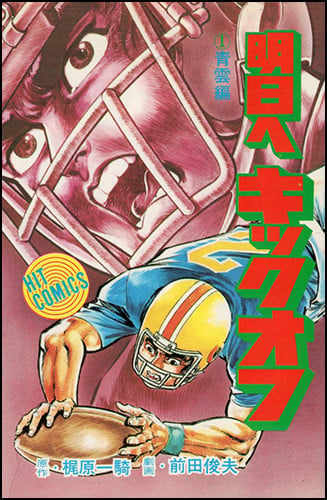
There was just one catch: these two big-name manga makers worked separately on their own individual football comics. Kawasaki's Football Hawk ran in Weekly Shōnen Magazine, while Kajiwara's Ashita e Kick-Off (not to be confused with popular soccer story Ashita e Free Kick!) ran in Weeky Shonen King. The writer Kajiwara got his title launched first, in August of 1976, and utilized the drawing talents of a newcomer—some 23-year-old upstart with just one serial under his belt, a kid named Toshio Maeda. Yep, that's right, almost a decade before unleashing Urotsukidoji upon the world, “Tentacle King” Maeda was drawing bone-crunching delinquent high school football action for the famous Kajiwara. This series focused more on football as a means for kids from the bad neighborhood to uplift themselves, and sadly, not a whole lot is known about it because just one collected volume was published. Kajiwara and Maeda kept Ashita e Kick-Off (aka Kick-Off to Tomorrow) going until October of 1977, so you'd think that a couple of more collected tankoban would've been published, but it didn't come to pass.
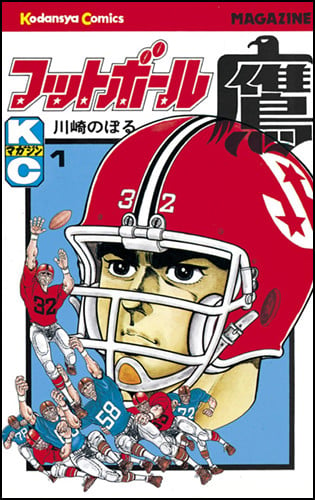
Noboru Kawasaki, on the other hand, found some sustained success with his serial, Football Hawk. The series, which hit newsstands in January of 1977, concerns the exploits of a talented high school and collegiate player named Taka Yuhino, who's scouted by coach Bob McKenzie and brought to the US as a potential NFL star. McKenzie eventually puts Taka on the O-line of his team, the Silver Stars, and Taka's exploits span a nifty 10 volumes of football action. Kawasaki's take on the game isn't as melodramatic as Kajiwara's, but his artwork is terrific, and the stories are well-researched, full of facts about real-life gridiron strategies and NFL teams. Football Hawk would be the most successful stab at the sport's depiction in manga for quite some time.
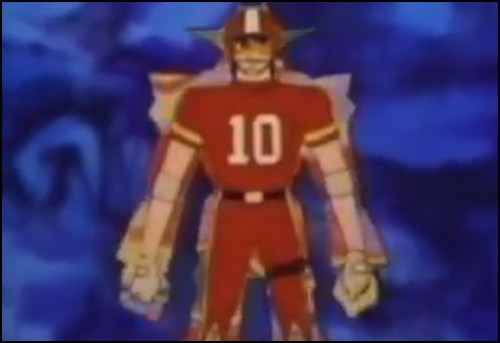
But if football gained a toehold in Japan's pop culture landscape in the 1970s, then there had to be football in anime, right? Well, of course there was. The thing is, nobody thought to get an actual football anime made, so fans of the sport had to settle for occasional motifs. In the 70s, this meant football making all sorts of odd appearances in sci-fi and super robot cartoons. Undoubtedly the most well-known of these is Dai-Apollon, which aired in 1976. Here's a super robot series where the heroes are all kitted out in football pads, complete with a stereotypical pink jersey for the girl character—not to mention a stereotypically red jersey for the leader, Takeshi. One day, Takeshi discovers that he's the son of an alien monarch, and has been left with his planet's ultimate weapon—three small robots that combine into the mighty and powerful and football-tastic Dai-Apollon! My favorite part of the show is its looney-tunes gattai/transformation sequence, in which Takeshi's body grows to gigantic size inside of the robot, and he wears it like a suit of armor. It's kind of disturbing to watch, because the show makes it clear that this transformation is painful for Takeshi! Anyway, Dai-Apollon is probably the best-known use of football in anime, but it wasn't the first.
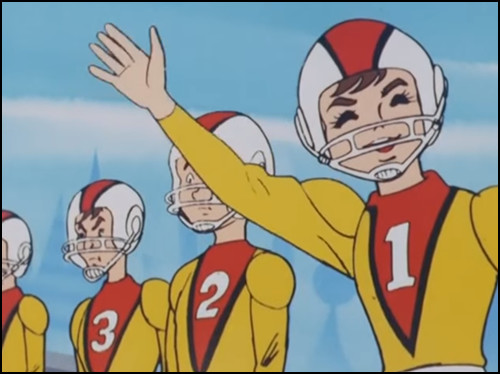
The first was arguably Charge Man Ken (Disclosure: I contributed to Discotek Media's release of Charge Man Ken on DVD.) One of Ken's better-known episodes, The Mysterious Handsome Boy, aired in April of 1974. Aside from the helmets, the outfits these children wear don't really resemble football pads, the animators struggle to communicate a competent rendering of the game of football, and the titular handsome young football star inevitably turns out to be a bloodthirsty alien in disguise, which Ken readily murders. Hey, I don't think that's a legal move in football!

Beyond that, football in anime is mostly a series of odd little hints and glancing depictions. The 1976 TV series Gowapper 5 Godam clearly uses football uniforms as an inspiration for its heroes' outfits, but that's as far as it goes. 1977's Balatack starts with main character Yuji playing in a big football game, before becoming a standard super robot series. Football is used as window dressing in the 1989 direct-to-video featurette Cipher, which is one of the most unusual OVAs ever made—a mood piece, filled with American music, and executed entirely in English. Main character Shiva is a popular actor in New York, and he ends up starring in a football movie called Winning Tough, which appears to be directed by a weird amalgam of Stephen Spielberg and Stanley Kubrick. Amusingly, Shiva is played by Jay Kabira, who would later go on to sporting stardom of his own… as a soccer commentator. You might know Jay as the over-the-top narrator in the Mr. Tonegawa anime!
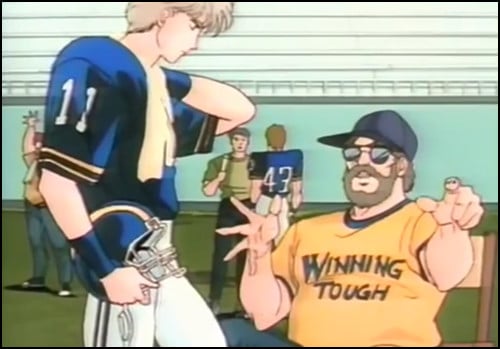
Other than those examples, the only glimpse of football in anime I can remember comes in 1993's 8th Man After OVA, which briefly depicts the gripping struggle between the Jokers and the Black Fighters. Wait a minute– Black Fighters?!
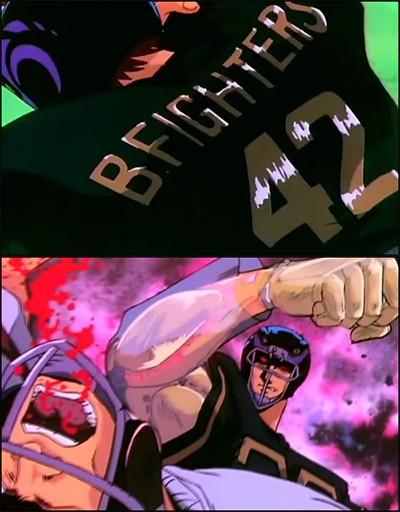
Yep. Yeah, I guess they did that! I'm sure the production team's intentions were good, but that's still an awfully awkward name to give in a sport where where… well, you get the picture. It's a good thing that there are no weird, kinda-racist team names in the NFL…! Wait a minute. Anyway, with the sport easily the most popular in the US in the 90s and 2000s, it was well past time for a smash hit to emerge on the comics pages. Finally, we got the one serialized action story that would make football the king of printed media!
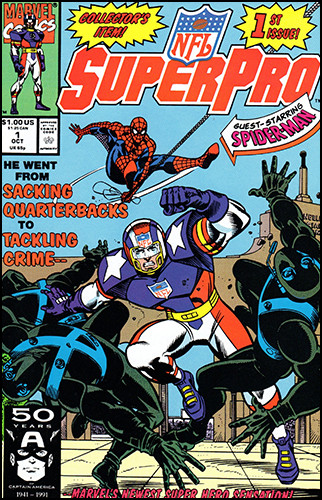
Wait a minute, that's not what I meant. NFL SuperPro only lasted about a year, and it'd be another solid decade before a true, sustained hit football comic would emerge. This time, it would be in the pages of Shonen Jump. See, I met a manga creator named Riichirō Inagaki at the inaugural Otakon Vegas in 2014. I had been looking forward to hearing his story of how he came up with the series Eyeshield 21, creating a sizeable American football hit in a nation where the sport still has a low profile. Inagaki readily explained his concepts for making Eyeshield 21 happen, mixing the technicalities of the sport with an exciting shonen battle setup that deployed the title character as sort of a gridiron Kamen Rider, a mysterious running back who executed amazingly swift and adroit offensive moves. Then, Inagaki did something that surprised me: the series writer grabbed a pen and dashed off an excellent-looking drawing of Yoichi, the wolfishly-grinning captain of the team. “We actually talked about having me draw the series myself,” Inagaki confessed. “Most manga writers can draw better than you'd think!”
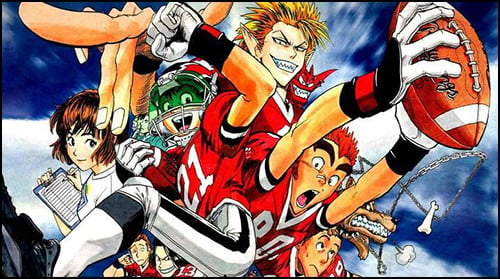
Ultimately, Inagaki would be paired up with manga superstar Yūsuke Murata. Together, the two would deliver Eyeshield 21, a 37-volume, utterly sincere, committed sports action series about gridiron football. The secret to the series' success is in Inagaki's formula—he envisioned a sports manga that would only be about 40% serious, with that proportion of the action devoted to careful breakdowns of the sports' technicalities. The other 60% would be all about high action, crazy plot twists, and of course, special moves. After all, why depict a running back executing a simple crossover, accelerating into a turn to beat their defensive markers, when you can call it the Devil Bat Ghost and depict the player literally vanishing into thin air?! My favorite of the story's many, many special moves is the Magnum Kick, a field goal drive that launches the ball a full 60 yards upfield. The longest field goal on record in the NFL is just 64 yards, so these high school kids are already playing at a very high level! Then again, Dirk Borgognone did kick a football 68 yards as a high schooler, so clearly the Devil Bats and their opponents have some room to improve.
Beyond the balance of action and technicality, Eyeshield 21 is a fun shonen team sports anime—if you've been digging Haikyu!!, you can go back and like this series for many of the same reasons, as its bashful and tentative hero Sena uses the sport as a platform to build friendships and rivalries. Inagaki also really does his homework on the ins and outs of football—at his panel I went to, he talked extensively about how he'd build formation charts and play diagrams, both to help himself keep the action straight and to help out his artist Murata. Interestingly, Inagaki said that he wasn't actually a big fan of football—while he came to the US to watch games and do research on the sport, he chose gridiron football because he felt it was especially well-suited to his whole Sports Kamen Rider concept. Naturally, a lengthy Eyeshield 21 TV anime soon followed the manga.
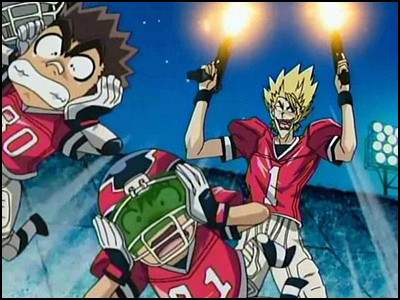
You'd think that a faithfully executed anime about football would quickly be exported to the US, but Eyeshield 21's localization ended up being a complicated mess. The show was ultimately set up for streaming, where it was planned to appear both on Toonami Jetstream and on NFL Rush, the football league's specialty website for kids. Several episodes were dubbed by a team led by voiceover veteran Tony Oliver, complete with a gloriously cheesy pop-punk theme tune, but they were weird franken-episodes that combined footage from all over the show's early going, stitched together with awkward digital transitions. The series never did show up on NFL Rush, and quietly disappeared from Toonami Jetstream shortly thereafter. I eventually managed to get webrips of those episodes, which look terrible, but I think I should be able to use footage from the DVDs to create a good-looking restoration of this weird, halting, and utterly failed attempt to link up football fandom with anime fandom. Hey man, it's a part of history, we gotta preserve it!
In the wake of the sport's biggest spectacle, I wonder if there'll be another attempt to span that bridge between football and anime. It's clearly worth doing, because the actual players love anime! Ex-NFL tackle Brennan Williams is an outspoken fan of the medium, and my very own Patriots have their own anime club. These old plans for positioning Eyeshield 21 on a league website would seem to hint that the NFL want to cultivate a crossover audience, though the eventual “let's make an animated series for NFL fans!” would lead to the confusingly-named NFL Rush Zone, which is not only not as good as Eyeshield 21, it isn't even really as good as Where's Huddles?, Hanna Barbera's attempt to recreate the Flintstones formula with pro football players. I'm sure that, if ardent fans of the sport and anime/manga keep rushing forward, they'll eventually break through for the touchdown. Oh, and as for that occasional football motif deal? There's one example I forgot to mention, one related to Gundam.
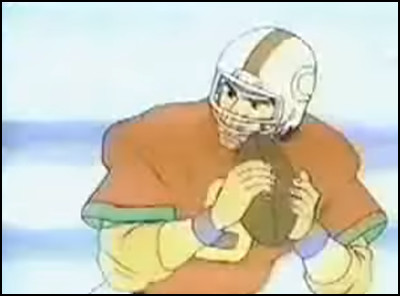
I'm talking about Doozy Bots. Why, what did you think I meant?!
discuss this in the forum (12 posts) |